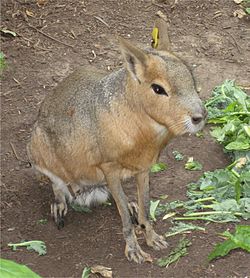- Mara (mammal)
-
- For other uses, see Mara.
Mara
Temporal range: Pleistocene - Recent
A male mara Scientific classification 
Kingdom: Animalia Phylum: Chordata Class: Mammalia Order: Rodentia Family: Caviidae Subfamily: Dolichotinae Genus: Dolichotis
Desmarest, 1820Species D. patagonum, Patagonian Mara
D. salinicola, Chacoan MaraThe maras (Dolichotis) are a genus of the cavy family. They are the sole representatives of the subfamily Dolichotinae.[1] These large relatives of guinea pigs are common in the Patagonian steppes of Argentina but live in other areas of South America as well such as Paraguay. Maras are the fourth largest rodent in the world, after capybaras, beavers, and porcupines, reaching about 45 cm (18 in) in height.
There are two species of maras recognised, the Patagonian Mara (Dolichotis patagonum), and the Chacoan Mara (Dolichotis salinicola).
Contents
Physical description
Maras have stocky bodies, three sharp-clawed digits on the hind feet, and four digits of the forefeet. Maras have been described as resembling long-legged rabbits. Patagonian Maras can run at speeds up to 29 km (18 mi) per hour. Maras can weigh over 11 kg (24 lb) in adulthood.
Most Maras have a brown head and body, a dark almost black rump with a white fringe around the base, and a white belly.
Maras may amble, hop in a rabbit-like fashion, gallop, or bounce on all fours. They have been known to leap up to 6 ft (1.8 m).
Maras mate for life, and may have from 1 to 3 offspring each year. Mara babies are very well developed, and can start grazing within 24 hours. They use a slightly hostile creche system, where one pair of adults keep watch for all the youngsters in the creche. If they spot danger, the young rush below ground into a burrow (usually dug by a burrowing owl), and the adults are left to run for it.
Interaction with humans
Patagonian Maras are often kept in zoos or as pets and are also known as "Patagonian cavies" or "Patagonian hares". They can be quite social with humans if raised with human interaction from a young age, though they avoid people in the wild. Maras may even change their habits from coming out in day to becoming nocturnal, simply to avoid social interaction.
Gallery
Patagonian Cavy at the Wildlife Ranch in San Antonio, TX.Closeup picture of a Patagonian Cavy.Mara at Tropical WingsSee also
References
- ^ Woods, Charles A.; Kilpatrick, C. William (16 November 2005). "Infraorder Hystricognathi (pp. 1538-1600)". In Wilson, Don E., and Reeder, DeeAnn M., eds. Mammal Species of the World: A Taxonomic and Geographic Reference (3rd ed.). Baltimore: Johns Hopkins University Press, 2 vols. (2142 pp.). p. 1555. ISBN 978-0-8018-8221-0. OCLC 62265494. http://www.bucknell.edu/msw3/browse.asp?id=13400210.
External links
Caviinae Galea
(Yellow-toothed
cavies)Dolichotinae Dolichotis
(Maras)Hydrochaerinae HydrochoerusCategoryCategories:- Cavies
- Mammals of Argentina
Wikimedia Foundation. 2010.





